 In December 2017 the Air and Space Forces started combat operations at three early-warning radars - in Barnaul, Yeniseysk (on the photo), and Orsk.
In December 2017 the Air and Space Forces started combat operations at three early-warning radars - in Barnaul, Yeniseysk (on the photo), and Orsk.
The radars in Barnaul and Yeniseysk are Voronezh-DM, the Orsk one is Voronezh-M. Construction of the radars started in 2013-2014 - Barnaul, Yeniseysk, and Orsk. The radars started initial operations in December 2016, allowing the defense minister to announce that all gaps in the early-warning coverage have been closed.
It's possible that this maybe the location of the new radar that is built to replace/augment Olenegorsk:
This could be the site for the "#Olenogorsk" #Voronesh-DM #Radar - although quite a distance from Olenogorsk pic.twitter.com/87pJ54H1O6
— rambo54 (@reutersanders) December 23, 2017
But it's too early to tell and some details don't quite add up - in a recent interview commander of the Space Forces said that the radar is being built "at a mountain with the height of 400 m." Google Earth doesn't show any mountains at this location.
This is the Google Earth file with radar coordinates and their fans. Russian early warning radars Jan 2018.kmz

Comments
Hello Pavel
How would You comment recent allegiations that Russian EW radars did not actually track Korean ICBMs.
See, for example https://www.c4isrnet.com/intel-geoint/sensors/2018/01/02/russias-radar-shortcomings-are-a-us-problem-now/
Personally, I'll bet on Lavrov's political play to invalidate the Americans' claims regarding Korean threat that are used to justifiy the development of US missile defence. But what do You think?
All the Best
Marek Czajkowski
That's a good question. And, frankly, I don't have a good answer. I find it hard to believe that Russia did not see the missile, but I find it equally hard to understand why Russia said it wasn't an ICBM.